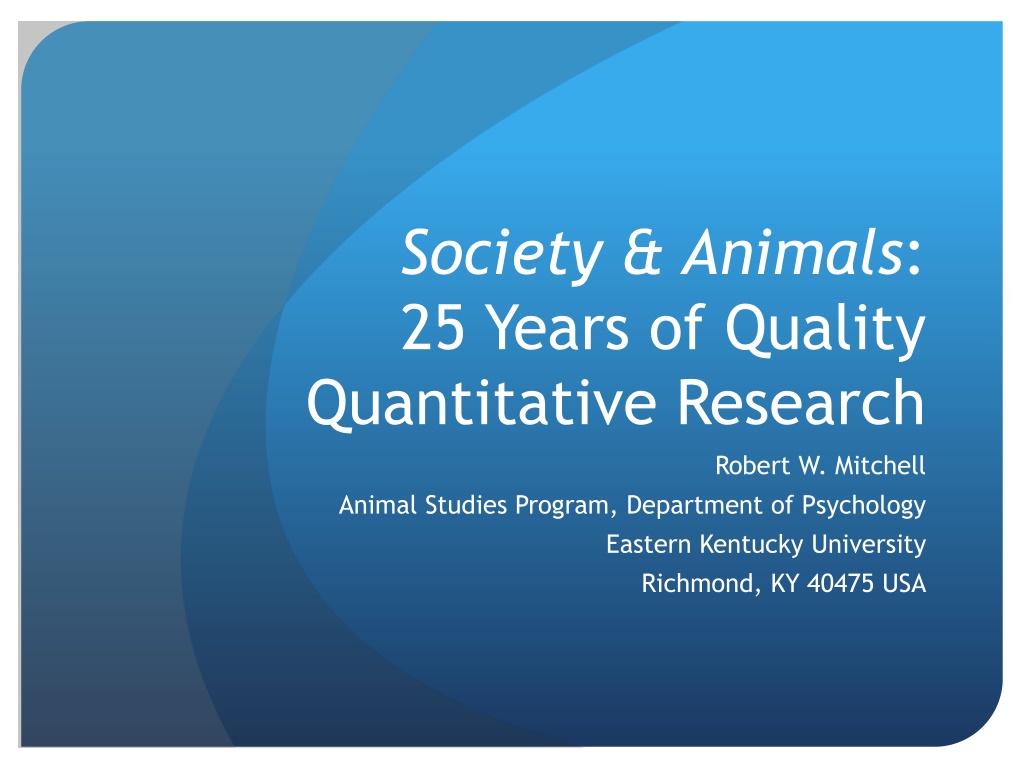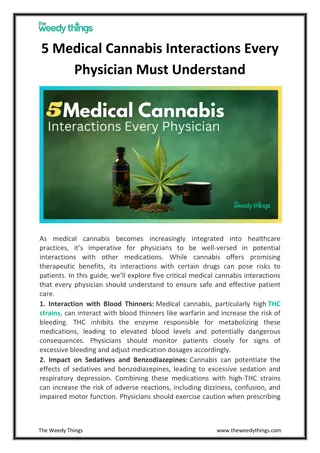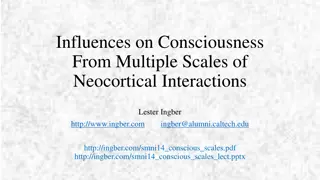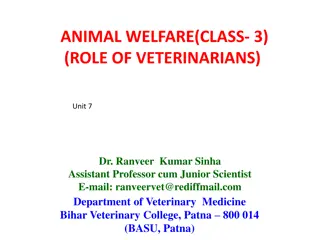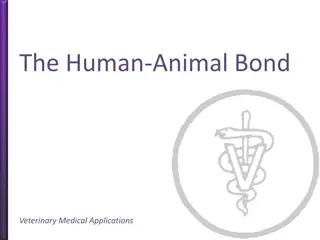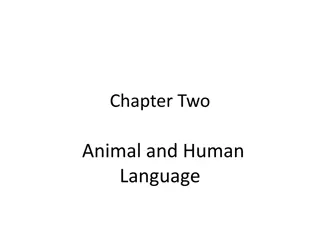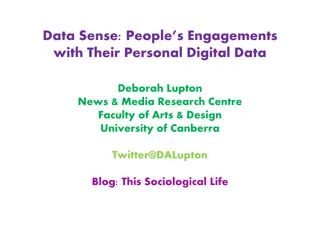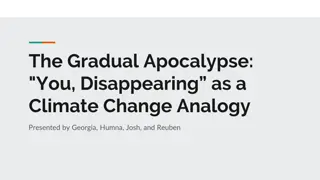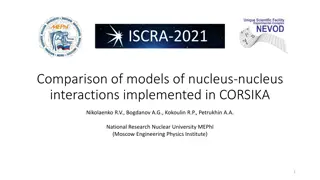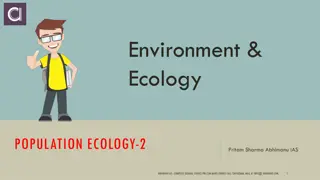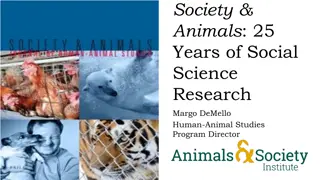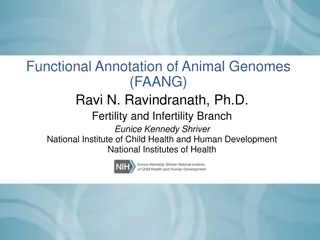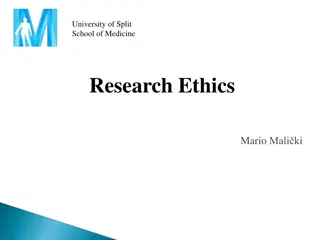Exploring Human-Animal Interactions through 25 Years of Quality Research
Delve into the interdisciplinary realm of human-animal interactions with a focus on social sciences and quantitative research. Discover key themes such as social psychology, therapy, animal welfare, and more. Explore attitudes and personality differences related to animal treatment, empathy, and beliefs about animal emotions. Gain insights into the evolving attitudes towards animals and the deepening human-animal relationships in contemporary society.
Download Presentation

Please find below an Image/Link to download the presentation.
The content on the website is provided AS IS for your information and personal use only. It may not be sold, licensed, or shared on other websites without obtaining consent from the author. Download presentation by click this link. If you encounter any issues during the download, it is possible that the publisher has removed the file from their server.
E N D
Presentation Transcript
Society & Animals: 25 Years of Quality Quantitative Research Robert W. Mitchell Animal Studies Program, Department of Psychology Eastern Kentucky University Richmond, KY 40475 USA
Initial focus on social sciences the purpose of S&A is to encourage social scientific studies of the human side of human/animal interactions. (Ken Shapiro & D. W. Rajecki, 1995)
Initial focus on social sciences the purpose of S&A is to encourage social scientific studies of the human side of human/animal interactions (Ken Shapiro & D. W. Rajecki, 1995) Main themes of quantitative research Social Psychology Therapy Animal Welfare, Human Health Evolutionary Psychology Geography
Social Psychology Attitudes and Attitude Change Cross-culture/Cross-tradition Education Philosophical attitudes Abuse Death and grief Personality, Gender Attachment Sexuality
Attitudes The Motivational Bases of Attitudes Toward Animals (Hills, 1993) Metaphoric Relationships with Pets (Belk, 1996) Public Attitudes Toward Animal Research: Some International Comparisons (Pifer, Shimizu & Pifer, 1994) Attitudes toward Animals: Species Ratings (Driscoll & Herzog, 1995) Reasons for Companion Animal Guardianship (Pet Ownership) from Two Populations (Staats, Wallace & Anderson, 2008) Changing Conceptions of Care: Humanization of the Companion Animal-Human Relationship (Fox & Gee, 2016)
Attitudes Personality Differences between Pro- and Antivivisectionists (Broida et al., 1993) Personality and Attitudes Toward the Treatment of Animals (Matthews & Herzog, 1997) Gender, Views of Nature, and Support for Animal Rights (Kruse, 1999) The Relationship between Empathy and Personality in Undergraduate Students Attitudes toward Nonhuman Animals (Erlanger & Tsytsarev, 2012) Belief in Animal Mind: Does Familiarity with Animals Influence Beliefs about Animal Emotions? (Morris, Knight, & Leslie, 2012)
Attitudes Savages, Drunks, and Lab Animals: The Researcher's Perception of Pain (Phillips, 1993) Us and Them: Scientists' and Animal Rights Campaigners Views of the Animal Experimentation Debate (Paul, 1995) Who or What Are the Rats (and Mice) in the Laboratory (Birke, 2003) Using Grounded Theory to Examine People' s Attitudes Toward How Animals are Used (Knight et al., 2003) Nonhuman Animal Experiments in the European Community: Human Values and Rational Choice (Peggs, 2010)
Attitudes Dreadful/Delightful Killing: The Contested Nature of Duck Hunting (McLoed, 2007) Intimate Familiarities? Feminism and Human-Animal Studies (Birke, 2002) Communication as a Solution to Conflict: Fundamental Similarities in Divergent Methods of Horse Training (Savvides, 2012) There Is No Wild : Conservation and Circus Discourse (Bell, 2015)
Attitudes and Attitude Change Pet Ownership and Adults' Views on the Use of Animals (Wells & Hepper, 1997) Us and Them: Scientists' and Animal Rights Campaigners Views of the Animal Experimentation Debate (Paul, 1995) Ethnic Variations in Pet Attachment among Students at an American School of Veterinary Medicine (Brown, 2002) Companion Animal Attitude and its Family Pattern in Kuwait (Al-Fayez et al., 2003) Beyond Dominance and Affection: Living with Rabbits in Post-Humanist Households (Smith, 2003)
Attitudes and Attitude Change Changing Attitudes toward California's Cougars (Wolch, Gullo & Lassiter, 1997) Kangaroos: The Non-Issue (Thorne, 1998) Making Wildlife Viewable: Habituation and Attraction (Knight, 2009) Public Attitudes toward Black Bears (Ursus americanus) and Cougars (Puma concolor) on Vancouver Island (Campbell, 2013) Non-Human Animal Abuse and Wildlife Trade: Harm in the Fur and Falcon Trades (Wyatt, 2014)
Attitudes and Attitude Change "Once You Know Something, You Can't Not Know It : An Empirical Look at Becoming Vegan (McDonald, 2000) Framing Animal Rights in the Go Veg Campaigns of U.S. Animal Rights Organizations (Freeman, 2010) Sympathy, Empathy, and the Plight of Animals on Factory Farms (Lutz, 2016) A Different Cut? Comparing Attitudes toward Animals and Propensity for Aggression within Two Primary Industry Cohorts Farmers and Meatworkers (Richards, Signal & Taylor, 2013)
Attitude Change via Education An In-Class, Humane Education Program Can Improve Young Students' Attitudes Toward Animals (Nicoll, Trifone & Samuels, 2008) Teaching Kindness: The Promise of Humane Education (Arbour, Signal & Taylor, 2009) Practical Work at School Reduces Disgust and Fear of Unpopular Animals (Randler, Hummel & Prokop, 2012) Do Zoos and Aquariums Promote Attitude Change in Visitors? A Critical Evaluation of the American Zoo and Aquarium Study (Marino et al., 2010)
Abuse The Abuse of Animals and Domestic Violence: A National Survey of Shelters for Women who are Battered (Ascione, 1997) Animal Abuse in Childhood and Later Support for Interpersonal Violence in Families (Flynn, 1999) Physical Cruelty Toward Animals in Massachusetts, 1975- 1996 (Arluke, 1997)
Abuse An Investigation into the Association between the Witnessing of Animal Abuse and Adolescents' Behavior toward Animals (Thompson & Gullone, 2006) Moral Disengagement and Attitudes about Violence toward Animals (Vollum, Buffington-Vollum & Longmire, 2004) From Animal Abuse to Interhuman Violence? A Critical Review of the Progression Thesis (Beirne, 2004)
Abuse The Relationship between Animal Cruelty, Delinquency, and Attitudes toward the Treatment of Animals (Henry, 2014) Buddhist Compassion and Animal Abuse in Thailand s Tiger Temple (Cohen, 2013)
Death and grief The Loss of Animal Companions: A Humanistic and Consumption Perspective (Stephens & Hill, 1996) Death of a Companion Cat or Dog and Human Bereavement: Psychosocial Variables (Planchon et al., 2002) Not by Bread Alone: Symbolic Loss, Trauma, and Recovery in Elephant Communities (Bradshaw, 2004) 'Dog Handlers' and Dogs' Emotional and Cortisol Secretion Responses Associated with Animal-Assisted Therapy Sessions (Haubenhofer & Kirchengast, 2007)
Attachment Health Correlates of Compatibility and Attachment in Human-Companion Animal Relationships (Budge et al., 1998) Pet Attachment and Dissociation (Brown, 2001) Ethnic Variations in Pet Attachment among Students at an American School of Veterinary Medicine (Brown & Katcher, 2002) People and Their Pets: A Relational Perspective on Interpersonal Complementarity and Attachment in Companion Animal Owners (Woodward & Bauer, 2007) Animals and Attachment Theory (Rockett & Carr, 2014)
Sexuality Characteristics of Juvenile Offenders Admitting to Sexual Activity with Nonhuman Animals (Fleming, Jory & Burton, 2002) Furries from A to Z (Anthropomorphism to Zoomorphism) (Gerbasi et al., 2008) Furries and the Limits of Species Identity Disorder: A Response to Gerbasi et al. (Probyn-Rapsey, 2011) Why so FURious? Rebuttal of Dr. Fiona Probyn-Rapsey s Response to Gerbasi et al. s Furries from A to Z (Anthropomorphism to Zoomorphism) (Gerbasi et al., 2011
Therapy Assessment of the Effectiveness of a Pet Facilitated Therapy Program in a Nursing Home Setting (Perelle & Granville, 1993) Animal-Assisted Prolonged Exposure: A Treatment for Survivors of Sexual Assault Suffering Posttraumatic Stress Disorder (Lefkowitz et al., 2005) The Effectiveness of Equine-Assisted Experiential Therapy: Results of an Open Clinical Trial (Klontz et al., 2007) Guinea pigs The Small Great Therapist for Autistic Children, or: Do Guinea Pigs Have Positive Effects on Autistic Child Social Behavior? (Kr kova, Talarovi ov & Olexov , 2010) Equine-Facilitated Psychotherapy: The Gap between Practice and Knowledge (Bachi, 2012)
Therapy Interaction with a Therapy Dog Enhances the Effects of Social Story Method in Autistic Children (Grigore & Rusu, 2014) Potential Benefits of Canine Companionship for Military Veterans with Posttraumatic Stress Disorder (PTSD) (Stern et al., 2013) Assessing the Dog: A Theoretical Analysis of the Companion Animal s Actions in Human-Animal Interactions (Vitztum & Urbanik, 2016) 'Dog Handlers' and Dogs' Emotional and Cortisol Secretion Responses Associated with Animal-Aassisted Therapy Sessions (Haubenhofer & Kirchengast, 2007)
Animal Welfare Press Reports of Animal Hoarding (Arluke et al., 2002) Illegal Hunting and Angling: The Neutralization of Wildlife Law Violations (Eliason, 2003) Death or Declaw: Dealing with Moral Ambiguity in a Veterinary Hospital (Atwood-Harvey, 2005) Making Wildlife Viewable: Habituation and Attraction (Knight, 2009) Journal of Applied Animal Welfare Science (1998)
Human Health Health Correlates of Compatibility and Attachment in Human-Companion Animal Relationships (Budge et al., 1998) Perpetration-Induced Traumatic Stress In Persons Who Euthanize Nonhuman Animals in Surgeries, Animal Shelters, and Laboratories (Rohlf & Bennett, 2005)
Evolutionary Psychology The "Disgusting" Spider: The Role of Disease and Illness in the Perpetuation of Fear of Spiders (Davey, 1994) Functions of Repetitive Talk to Dogs during Play: Control, Conversation, or Planning? (Mitchell & Edmonson, 1999) Anthropomorphism and Anthropomorphic Selection Beyond the "Cute Response" (Serpell, 2002) The Wild Side of Animal Domestication (Russell, 2002) Designer Cows: The Practice of Cattle Breeding Between Skill and Standardization (Grasseni, 2005)
Geography Animal Domestication in Geographic Perspective (Anderson, 1998) Kangaroos: The Non-Issue (Thorne, 1998) New Places for "Old Spots": The Changing Geographies of Domestic Livestock Animals (Yarwood & Evans, 1998) More Than a Furry Companion: The Ripple Effect of Companion Animals on Neighborhood Interactions and Sense of Community (Wood et al., 2007)
Geography Discourse and Wolves: Science, Society, and Ethics (Lynn, 2010) Global Climate Change and the Industrial Animal Agriculture Link: The Construction of Risk (Bristow, 2011) The Slaughterhouse, Social Disorganization, and Violent Crime in Rural Communities (Jacques, 2015)
S&As focus on social sciences the purpose of S&A is to encourage social scientific studies of the human side of human/animal interactions. (Ken Shapiro & D. W. Rajecki, 1995) Society & Animals accomplished this goal! More submissions from non-English speakers (anecdotal) Develop better measures of effectiveness of animals as therapists New direction: a greater focus on nonhuman animal side of the nonhuman/human animal interaction
